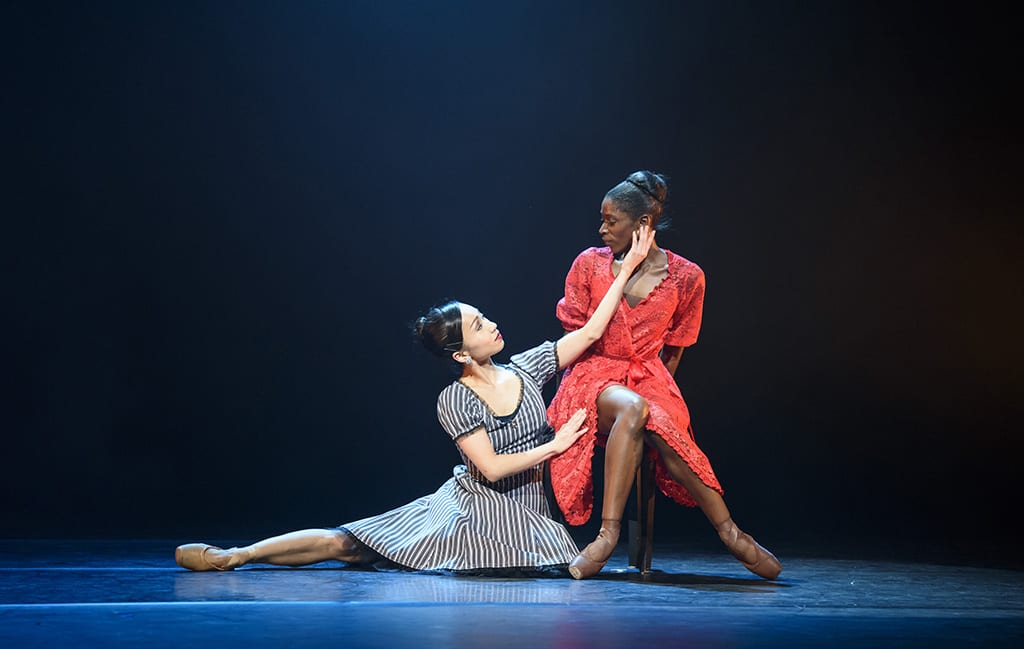With this triple bill, Ballet Black, renowned for its eight-person company of Asian and black dancers, is true to artistic director Cassa Pancho’s promise to make ballet accessible by proposing a varied range of performances that are approachable and varied in atmosphere.
Cristaux provides a brief, but impressive opening in the form of a somnambulant pas de deux. Choreographed by Arthur Pita, the piece evinces a feeling of hardness coupled with dream-like ethereality. Sheathed in a white dress covered in scintillating gems, Cira Robinson enters the stage to the mineral notes of Steve Reich’s Drumming Part III, which matches the audible staccato of her pointes. Her duet with Mthuthuzeli November, she doll-like, he all undulations and twirling arms, hovers between attraction and reluctance. The two swiftly circle around the stage and reunite in cold embraces, avoiding each other’s eyes. Their faces are still, their movements often rigid, illuminated by the cold shimmers of Robinson’s dress on the stage. In the last moments of this thrilling vision, November’s lying body twitches and jerks, as if we had been witnessing his dream or, perhaps, his nightmare.
In To Begin, Begin, six dancers map out a man’s sentimental journey. The composition has a thoughtful and tender feel to it, exploring love’s ups and downs in a series of expressive duets and trios. A rippling piece of turquoise silk circulates between the dancers, serving in turn as a woman’s train, watery billows or lovers’ sheets. The device is best put to use when it becomes integrated to the choreography, and is not only used for transitions. If Cristaux was the tale of a failed encounter, To Begin, Begin, celebrates the communion of its performers.
Finally, Christopher Hampson’s successful Storyville, first presented in 2012, makes its return in a slightly extended version. By contrast with the two previous parts, Storyville, which borrows references from the musical and doesn’t shy away from songs, has a very clear narrative thread. We follow the misfortunes of Nola (Cira Robinson), a young girl lost in 1920s New Orleans. A perky sign-bearer walks across the stage between each scene to mark chronological transitions. Cira Robinson shows herself to be an excellent performer for the second time tonight, as does Sayaka Ichikawa. The latter plays the treacherous Lulu White, a fallen woman who throws Nola in the clutches of sinister Mack (José Alves), a character inspired by Brecht’s Threepenny Opera. Some highlights involve Nola’s alluring solos, a voodoo ritual (especially adequate for a Halloween weekend) and a drunken ensemble.
Finally, it is not every night that you see dancers performing from so short a distance that you can hear the sound of their feet tapping on the floor. Is ballet best admired from a slight distance, to leave its magic undisturbed, or seen, heard and felt from up-close? Seated, as I was, a few metres away from the stage, I had time to ponder that question. I came to two conclusions. The first is a piece of friendly advice: if you go to the Tramway, you should hurry to get in first and sit as close as you can. Here’s the second: watching Ballet Black’s triple bill so closely, I was fascinated by the dancers’ seemingly effortless performance, their faces radiant as they went from one demanding piece to another. Pita’s choreography was, to me, the strongest of the three, but this triple bill has something for everyone.

